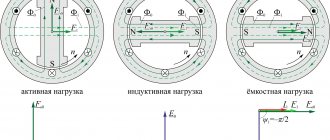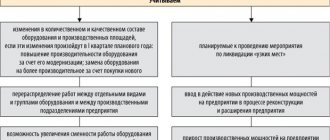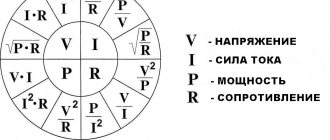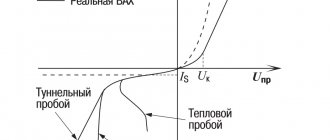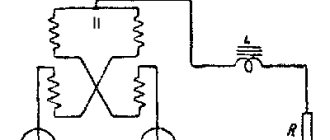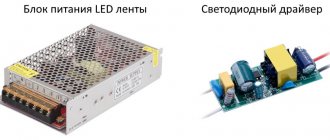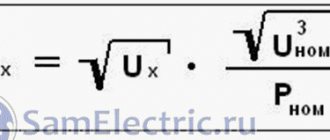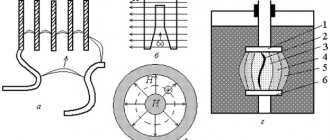Electrical power, designated in the diagrams by the letter P, is a physical quantity that characterizes the rate of conversion or transmission of electricity. The standard concept is the effort to move an electric charge along a route from point F1 to point F2.
The electrical power of a device is a key parameter that determines the potential for its operation in the electrical network. Used to calculate circuits and operating modes of equipment to ensure the safety of electrical networks. The greater the power of the device, the faster they perform the desired action.
Formulas for calculating voltage, current, power, resistance Source amperof.ru
Electrical current through voltage and current
Since the potential difference calculated by the formula (F1-F2) determines the voltage (U), it is easy to conclude that the relationship established by Ohm’s law cannot be used. Electrical power (P) is also qualified by the current strength (I) on a specific section of the line. Final expression: P = U x I.
What is the load determined in terms of current and resistance?
Through a simple conversion, the electrical energy consumption is determined using the following formula: P = I2 x R. This shows the dependence of the power on the nominal value of the resistor connected to the line of the network element. For a complete circuit, the source resistance (internal) and the conductance of the connection point are indicated.
Joule-Lenz law
In the case when no mechanical work is performed on a section of the circuit, and the current does not produce chemical effects, only heating of the conductor occurs. A heated conductor gives off heat to surrounding bodies.
The law determining the amount of heat that a current-carrying conductor releases into the environment was first established experimentally by the English scientist D. Joule (1818-1889) and the Russian E.H. Lentz (1804-1865). The Joule-Lenz law is formulated as follows:
Joule-Lenz law
The amount of heat generated by a current-carrying conductor is equal to the product of the square of the current, the resistance of the conductor and the time the current passes through the conductor.
Q=I2RΔt
The amount of heat is measured in Joules (J).
Example No. 2. Determine how much heat was released in 2 minutes by a conductor at a voltage of 12 V and a resistance of 2 Ohms.
We use Ohm's law and the Joule-Lenz law:
Q=I2RΔt=(UR..)2Δt=U2R..Δt=1222..=72 (J)
What is it and how to calculate the load
Electric current load is a quantity characterizing its properties. Shows how much energy is consumed by electrical appliances. The current power is measured using a special device - a wattmeter.
If you connect a meter in series, you can check the current strength. When connecting in parallel, the voltage is determined. The amount of circuit consumption is calculated using the formulas: P = I x U or P = U2/ R = I2 x R.
The electrical load is equal to the voltage across the consumer multiplied by the amount of current flowing through it.
P = U x I
The formula indicates which measurements determine this parameter. If the load is active, it is measured in Watts, the reactive unit of electrical power is VA.
Reactive unit of electrical power - VA Source infourok.ru
The process of measuring active and reactive power
Induction or electronic meters measure the active power of an alternating voltage circuit. They are connected using the same circuits as wattmeters. Reactive energy in single-phase consumers is not metered in our country. It is metered in three-phase circuits of large industrial enterprises that consume large volumes of electricity. Active energy meters are marked SA, reactive SR. Electronic electricity meters are also widely used.
How to determine the maximum current load
The useful power shows the maximum value in a situation where the load resistance R is compared with the same parameter inside the source - r.
R = r.
P max = E2 / 4r, where E is the driving force of the current source.
To calculate the maximum current load for an electrical device, you need to know the rated load parameter and the AC input voltage. The technical data sheet of the device, manual or emblem contains the first indicator.
For example, when the appliance rating (P) is 12 W, the maximum current consumption at AC voltage will be for:
- 120 V – I = 12/120 = 0.100 A or 100 mA.
- 220 V – I = 12 / 220 = 0.055A or 55 mA.
If necessary, the amount of electricity consumed is expressed through a complex value. For this purpose, basic relationships are used, impedance is used instead of resistance.
What factors influence current power
Direct current is affected by only two quantities: the strength of the electric current (in amperes) and the voltage (in volts). From the formula described above, it becomes clear that the power characteristic of a constant electric current is calculated as the product of the electric current in this network and the voltage.
Note! If a source of electromotive forces is connected to the circuit, P will also depend on it, and to be more precise, it will be measured as the current strength multiplied by the emf.
You may be interested in this Designation wat
Electrical Appliances Parameters
Every modern apartment must be equipped with electrical appliances. To connect them to the network, it is necessary to draw up a schematic diagram where the loads connected to individual lines will be distributed in coordination with each other. It is necessary to build in a circuit breaker based on the PUE to prevent emergency situations.
First, the electrical wiring parameters are clarified. Then they are checked according to the group diagram for connecting to the network of household electrical appliances.
Standard characteristics of electrical power consumption (W):
- desktop computer – 170-1,250;
- LCD TV – 120 – 265;
- laptop – 40-280;
- air conditioning – 1,200 – 2,500;
- iron – 450-1850.
To protect the network, you need an automatic machine; we choose it taking into account all the significant factors.
Automatic switch for protecting the electrical network Source vmasshtabe.ru
It is important to pay attention to loads that have increased reactive energy parameters.
Cosine phi for various consumers - table
| Name of electrical appliance | cos φ |
| Boiler | 1 |
| Bulgarian | 0.8 |
| Vacuum pump | 0.85 |
| Induction furnaces | 0.85 |
| Compressor | 0.7 |
| Computer | 0.95 |
| Coffee maker | 1 |
| Gas discharge lamps | 0.4-0.6 |
| Fluorescent lamps | 0.95 |
| Incandescent lamps | 1 |
| Heater | 1 |
| Hammer | 0.85 |
| Vacuum cleaner | 0.9 |
| Microwave | 1 |
| Washing machine | 0.9 |
| TV | 1 |
| Iron | 1 |
| Hairdryer | 1 |
| Fridge | 0.95 |
| Electric drill | 0.85 |
| Electric motors | 0.7-0.8 |
| Electric stove | 1 |
| Electric arc welding | 0.3-0.6 |
| Electric kettle | 1 |
What is it measured in?
The unit of measurement of electrical power is W for Russia. By international standards - W. This is the energy provided per unit of time. One W is equal to a joule per second (J/s). Moreover, a joule is a unit of electrical power, a second is a unit of time.
For small values, multiple prefixes are used: “milli-”, “micro-”, for large values - “mega-”. For example: 5,800 W = 5.8 kilowatts = 5.8 kW.
When you multiply 1 Kilowatt by 1 hour, you get a Kilowatt-hour (kW x h). This is a unit of measurement of the amount of electricity provided to subscribers. It is used by energy enterprises that own the appropriate equipment (generators and transformer substations). They generate and convert the produced electricity, which is then distributed to consumers.
In the same way, the energy capacity of batteries is measured in units of ampere hours (Ah). Portable types of energy storage batteries are measured in milliampere hours (mAh).
The energy in batteries is measured in milliamp hours (mAh). Source listtopa.ru
For the unit of measurement Watt, according to international standards, the letter designation W is allocated after James Watt. He was the first to use the term “horsepower,” which today is an obsolete unit of the W parameter.
Energy conversion indicators:
- horsepower (HP) - 746 W;
- kilo Watts (kW) – 1×1000 W;
- megawatts (MW) −1×1000000 W;
- gigawatt (GW) – 1×1000000000 W.
Today, "horsepower" is used to indicate the second measure of engine power in vehicles.
Units of electrical current used in practice
The passports of electricity consumers - light bulbs, stoves, electric motors - usually indicate the strength of the electric current in them. Based on power, it is quite simple to find the work done by electric current over a given period of time; you just need to use the formula A = P*t.
Expressing power in watts and time in seconds, we get work in joules: 1 W = 1 J/s, where 1 J = 1 W*s.
But this unit of work is inconvenient to use in practice, since electrical receivers consume it over long periods of time, as, for example, in household appliances - for several hours, in electric trains - for several hours or even a day, and the calculation of consumed energy is based on In most cases, the electric meter is checked once a month.
Therefore, when calculating the work of a current or the energy consumed and generated, in all these cases it is necessary to convert these time periods into seconds, which complicates the calculations.
Peryshkin A.V. Physics 8. – M.: Bustard, 2010. [2]
Therefore, in practice, when calculating the work of electric current, it is more convenient to express time in hours, and the work of electric current not in joules, but in other units: for example, watt-hour (Wh), hectowatt-hour (gWh), kilowatt-hour (kW*h).
Peryshkin A.V. Physics 8. – M.: Bustard, 2010. [2]
The following relationships will be true:
- 1 Wh = 3600 J;
- 1 gWh = 100 Wh = 360,000 J;
- 1 kWh = 1000 Wh = 3,600,000 J.
Task. There is an electric lamp designed for a current of 100 watts. The lamp works for 6 hours every day. We need to find the work of electric current for one month (30 days) and the cost of consumed electricity, assuming that the tariff is 500 kopecks per kW/h.
Let's write down the condition of the problem and solve it.
Input data : P = 100 W, t = 6 h * 30 = 180 h, tariff = 500 kW/kWh.
The solution of the problem. We know that A = P*t, so we get: A = 100 W*180 h = 18,000 W*h = 18 kW*h.
We calculate the cost as follows: Cost = 500 kW*h * 18 kW*h = 9000 kopecks = 90 rubles.
Answer: A = 18 kWh, cost of consumed electricity = 90 rubles.
What determines the load of electric current?
Existing electrical wiring lines experience resistance during the movement of electrons, which characterizes voltage loss. Circuits where an alternating current source is present have one feature - the key role here is played by a sinusoidal oscillation of electrical indicators.
Sinusoidal oscillation of electrical indicators. Source urpsvet.ru
The following information will allow you to select the best calculation method based on actual network conditions.
Instantaneous electrical power: calculating the value
This indicator establishes the instantaneous values of the measured data. The key definition is considered taking into account the fact that a single simple charge (q) moves in a certain time Δt. To perform a specific action, the energy of electric current PF1-F2 = U/ Δt or (U/ Δt) x q = U x (q/ Δt) is expended. The formula takes into account the movement of q over the period Δt. Since the current, according to the classical definition, is equal to the charge moving from F1 to F2 (I = q/ Δt), the final expression is derived: PF1-F2 = U x I.
Conditionally assuming that the time period is very short, we obtain the instantaneous power for part of the electrical circuit P(t) = U(t) x I(t). The same conclusions can be drawn taking into account the corresponding resistance parameter: P (t) = (I (t))2 x R = (U(t))2/ R.
Open and closed circuits
Let's start with the simplest flashlight circuit and we will start from it.
Here we see three radio elements: the Bat power supply, the S switch and a round sign with a cross inside, that is, a light bulb. All this together is called an electrical circuit . Since no electric current flows through the circuit, such a circuit is called open .
But as soon as we flip the switch, the light bulb immediately turns on. Such a chain will already be called closed .
Electrical power: DC circuit
The previously mentioned formulas are shown without correction factors. They are used to calculate a circuit connected to a direct current source. Using an ordinary device - a multimeter, with the switch in the correct position, the resistance of the load connected to the network is set.
With its help, the load resistance is set. Source hammer-shop.ru
Example of calculating total power for an electric motor
Of particular interest is the load connected to a three-phase network, since the electrical quantities flowing in it directly depend on the rated load of each phase. But to make the example clearer, we will not consider how to find the power of an asymmetrical device, since this is a rather complex task, but we will give an example of calculating a three-phase motor.
The peculiarity of the power supply of both asynchronous and synchronous electric machines is that both phase and linear voltage can be supplied to the windings. This or that option, as a rule, is determined by the method of connecting the electric motor windings. Then the power will be calculated using the formula:
S = 3*Uф*Iф
In the case of performing calculations with linear voltage, to find the power, the formula will take the form:
Active and reactive power will be calculated by analogy with alternating current networks, as discussed earlier.
Now let's look at the calculations using the example of a specific asynchronous electric machine. It should be noted that the official performance indicated in the passport data of the electric motor is the useful power that the engine can produce when making shaft revolutions. However, useful is fundamentally different from total, which can be calculated using power factor.
Rice. 2. Motor nameplate
As you can see, for calculations from the nameplate we will take the following information about the electric motor:
- useful performance – 3 kW, and translated into a measurement system – 3000 W;
- efficiency factor is 80%, and in recalculation for calculations we will use the indicator 0.8;
- trigonometric function of the ratio of active and reactive components – 0.74%;
- the voltage when connecting the windings in a triangle will be 220 V;
- current strength with the same connection method is 13.3 A.
With this list of characteristics, you can use several ways:
S = 1.732*220*13.3 = 5067 W
To find the desired value, we first determine the active component:
P = Puseful / efficiency = 3000/0.8 = 3750 W
Further, complete by the method of dividing the active by the coefficient cos φ:
S = P/cos φ = 3750/0.74 = 5067 W
As you can see, in both the first and second cases the desired value turned out to be the same value.
Electrical power: AC circuit
For such lines, it is unacceptable to use formulas that determine instantaneous parameters, since the final indicator changes from a minimum value to a maximum value with the network frequency. A typical single-phase 220 V network is characterized by a 50 Hz sinusoidal signal. It is allowed to use the simple formula P = U x I when connecting devices with resistive parameters:
- Heating elements of washing machines;
- spirals of infrared heaters;
- incandescent light bulbs.
Using this formula, the load is set.
Units of measurement and designation
The unit of power in the International System of Units (SI) is the watt. In this case, the Russian designation: W , international: W ). 1 W = 1 J/s. From the formula P = U*I it follows that: 1 watt = 1 volt * 1 ampere, or 1 W = 1 VA.
There are also power units that are multiples of watts: hectawatt (gW), kilowatt (kW), megawatt (MW). In other words, 1 GW = 100 W, 1 kW = 1000 W, 1 MW = 1,000,000 W.
The units of power used in electrical engineering are multiples of the watt: microwatt (µW), milliwatt (mW), hectowatt (gW), kilowatt (kW) and megawatt (MW). In other words, 1 µW = 1*10-6 W, 1 mW = 1*10-3 W, 1 gW = 1*102 W, 1 kW = 1*103 W, 1 MW = 1*106 W.
Each electrical appliance has a certain power (indicated on the device). Here are typical wattage ratings for some electrical appliances.
| Device | Power, W |
| TV in standby mode | 0,5 |
| Flashlight lamp | About 1 |
| Incandescent lamps | 25-150 |
| Fridge | 160 |
| Electric heater | 500-2000 |
| Vacuum cleaner | Up to 1300-1800 |
| Electric kettle | Around 2000 |
| Iron | 1200-2200 |
| Washing machine | Up to 2300 |
Previously, the unit of measurement used to denote power was horsepower (hp), which is still known today. Convert from horsepower to watts using the expression: 1 hp. = 735.5 W.
Energy can be of two types: reactive and active.
Active is the true electrical power that produces real work in the load, W shows this parameter. It converts energy into mechanical, thermal and other forms.
If you turn on a powerful unit or capacitor, the voltage inside the network drops. Such loads create an oscillating circuit that receives energy from the power source. In this situation, only P act components perform useful functions. The active indicator is calculated in the following way:
- U x I – direct current (alternating current with a resistive load);
- U x I x cos fi – for a single-phase 220 V line;
- U x √3 x cos fi = U x 1.7321 x cos fi – 3-phase network, U x √3 x 380V.
There are other types of energy, but more on that later.
Active and passive energy Source ppt-online.org
Reactive power
This indicator shows the loads that are created in devices due to fluctuations in the energy of the electromagnetic field.
Reactive power, regardless of the absence of useful work, must be taken into account to correctly evaluate key network data. Cables and wires, when current passes through them in any direction, heat up. This happens quite cyclically. Energy effects at high intensity:
- damage cable cores and protective insulation;
- contribute to the occurrence of a short circuit;
- destroy the windings of transformers and drives.
Reactive power is expressed as VA (volt-amperes) and is calculated by multiplying the voltage by the current and the shear angle:
P r = U x I x sin fi.
When connecting a load with capacitive parameters, the value becomes negative, when inductive it becomes positive. Since the characteristics of the magnetic field change, the unit of measurement for reactive power is VA.
If the parameters of total electrical power are shown as vectors, a triangle appears. The length of its sides will be equal to the amount of electricity consumed by a particular component. The angle between the apparent power (Pap) and the active power (ϕ) is used for calculations. The total value is determined by the expression: P total = √((P act)2 + (P react)2).
Selection of circuit breaker rating
Mechanical Power Formula - Average and Instantaneous Power
To solve practical problems when connecting several consumers to a standard 220 V home network, the total current strength in individual lines is calculated.
Calculation procedure for one household air conditioner:
- power consumption – 1,250 W;
- cosϕ – 0.75;
- I = 1,250/ (220 * 0.75) = 7.58 A.
Other consumers make calculations in a similar way. Less powerful devices are combined into a unit for connection to one line. Make the necessary adjustments taking into account placement in order to economically use cable products. A suitable machine is selected from the standard model range in the higher side of the nominal value (with a reserve of current strength).
Next, check the compliance of the conductors. The cross-sectional area is calculated using the well-known geometric formula:
S = ¼ * π * d2.
Next, according to the table from the PUE, select the appropriate option. For the example presented above, when connecting only one air conditioner, it is enough to use a copper conductor with a cross-sectional area of 1.5 mm square. This is enough for long-term transmission of current up to 19 A.
What is power in electricity
Voltage is the work done to move a unit of charge. Current is the number of coulombs moved in 1 second. When multiplying the first parameter by the second, the total amount of work done in 1 second is obtained.
The strength of electricity is a numerical current meter that characterizes its energy qualities. The power indicator equally depends on voltage and current strength. How is current power measured? To measure this parameter, a Wattmeter is used; the unit of measurement is designated in the same way - W (Watt).
By using the dependence of the power parameter on current and voltage, specialists can transmit electricity over long distances. For these purposes, energy is converted at step-down and step-up transformer substations (transformer substations).
The concept of electrical power and methods for calculating it
From an electrical engineering point of view, it is a quantitative expression of the interaction of energy with conductor material and elements during the flow of current in an electrical circuit. Due to the presence of electrical resistance in all parts involved in conducting electric current, the directional movement of charged particles encounters an obstacle along the way. This causes the collision of charge carriers, electrical energy transforms into other forms and is released in the form of radiation, heat or mechanical energy into the surrounding space. The conversion of one type to another is the power consumption of the device or section of the electrical circuit.
Depending on the parameters of the current and voltage source, power also has distinctive characteristics. In electrical engineering it is denoted by S, P and Q, the unit of measurement according to the international SI system is watts. Power can be calculated through various parameters of instruments and electrical appliances. Let's look at each of them in more detail.
Through voltage and current
The most relevant way to calculate power in DC circuits is to use current and applied voltage data. To do this you need to use the calculation formula: P = U*I
Where:
- P – active power;
- U – voltage applied to a section of the circuit;
- I is the strength of the current flowing through the corresponding section.
This option is only suitable for active loads, where direct current does not provide interaction with the reactive component of the circuit. To find power you need to multiply current and voltage. Both quantities must be in the same units of measurement - Volts and Amperes, then the result will also be in Watts. You can use other methods kV, kA, mV, mA, μV, μA, etc., but the power parameter will proportionally change its decimal value.
Through tension and resistance
For most electrical devices, such a parameter is known as internal resistance, which is taken as a constant for the entire period of their operation. Since domestic or industrial units are connected to a source with a known voltage rating, determining the power is quite simple. The active power is found from the previous relationship and Ohm's law for a section of the circuit, according to which the current in the section is directly proportional to the magnitude of the applied voltage and has inverse proportionality to the resistance:
I = U/R
If the expression for calculating the current load is substituted into the previous formula, you will get the following expression for determining the power:
P = U*(U/R)=U2/R
Where,
- P – load value;
- U – applied potential difference;
- R – load resistance.
Through current and resistance
There is a situation when the potential difference applied to an electrical device is unknown or requires labor-intensive calculations, which is not always convenient. This issue is especially relevant if several devices are connected in series and you do not know how the consumed electricity is distributed between them. The definition approach here is no different from the previous method; it is based on the basic statement that the electrical load is calculated as P = U×I , with the difference that we do not know the voltage.
Therefore, we will also derive it from Ohm’s law, according to which we know that the voltage drop on any section of a line or electrical installation is directly proportional to the current flowing through this section and the resistance of the circuit section:
U=I*R
after substituting the expression into the power formula, we get:
P = (I*R)*I =I2*R
As you can see, the power will be equal to the square of the current multiplied by the resistance.
Apparent power in AC circuit
AC networks are fundamentally different from direct current in that changes in electrical quantities lead to the appearance of not only an active, but also a reactive component. As a result, the total power will also consist of active and reactive energy:
Where,
- S – total power
- P – active component – occurs when electric current interacts with active resistance;
- Q – reactive component – occurs when electric current interacts with reactance.
Also, the components are calculated through trigonometric functions, like this:
P = U*I*cosφ
Q = U*I*sinφ
which is actively used in the calculation of electrical machines.
Rice. 1. Power triangle
Electrical power and inactive power
Equipment certificates contain active load - power factor, which is an important characteristic. It shows how efficiently a household appliance consumes electricity.
Fig.8
This is a number from −1 to 1, it is never equal to one. This coefficient depends on the type of load: C, L or R. The first 2 negatively affect PF = cos φ of the system. If its parameter is large, the current consumed by the devices increases. Many power loads are inductive, causing the current to lag behind the voltage.
Inactive energy arises in electrical AC circuits of alternating current networks. It is calculated simply: the square root of the sum (Pa2 + Pr2). If the reactive load is zero, then the passive load is equal to the modulus |Pa|.
The presence of nonlinear current distortions in electrical networks is caused by non-compliance with the direction that occurs between U/I, since the energy has a pulsed nature. In nonlinear modes, the apparent current power (EP) increases. Such a load is inactive and consumes Pr and current distortion energy. The unit of measurement is the same as regular power W.
Instruments for measuring quantities
Voltage formula
Individual parameters can be measured using specialized instruments. Ammeters are connected to an open circuit. Voltmeters - to the load output terminals.
Ammeter connection diagram
High currents are measured indirectly using a calibrated resistance (shunt). Specialized pliers are also used, which form a closed circuit of the inductor when connected. The calculation methods discussed above in AC networks are used taking into account the reactive parameters of the connected equipment.
